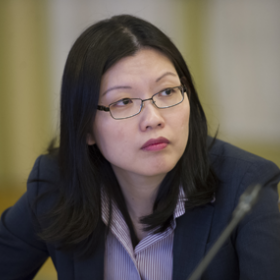
The U.S.-China Agenda for Obama’s Second Term
As President Obama embarks on his second term and China completes its leadership transition in March, EWI’s Senior Associates Jacqueline McLaren Miller and Piin-Fen Kok discuss the prospects for dealing with the continuing tensions in U.S.-China relations—and what can be done to overcome the distrust between these two key players that remains all too visible.
1. What were the successes and challenges in the first term in the U.S.-China bilateral relationship?
Miller:
After four years, we’re actually hard pressed to find concrete successes in the vital U.S.-China relationship. Perhaps the best that can be said is that the relationship did not deteriorate further, which is actually no small achievement. The few concrete successes have done little to overcome the mutual mistrust that still prevails. That is the most enduring problem that President Obama will face in his second term.
During his 2008 campaign, Obama offered tough talk about China. Once he took office, he dramatically moderated his tone. His administration initially tried to accommodate Chinese concerns in the hopes of generating good will and greater cooperation in dealing with many of the most pressing bilateral and global challenges. They included the global financial crisis, the currency dispute with China, climate change, and Iran and North Korea’s nuclear programs.
But Obama’s efforts at partnership did not lead to the desired results: China was slow to address concerns over its currency and industrial policies; it snubbed Obama at the Copenhagen climate discussions; it was reluctant to apply pressure on North Korea; and it adopted more assertive regional policies. There was some progress on Iran as China supported UN sanctions in 2010, but then China refused to support new sanctions designed to undermine Iran’s continued progress on its nuclear program.
After the conciliatory approach produced little success—a charge critics were quick to make about Obama’s “soft” approach—the administration adopted a tougher stance toward China while continuing to seek expanded opportunities for dialogue. That’s the approach that is largely in place today.
Kok:
I agree that the biggest achievement was that both sides managed not to escalate tensions. Cool heads prevailed in managing the tense confrontation between the Impeccable, a U.S. Navy frigate, and Chinese ships in 2009, offering a stark contrast to the loudspeaker diplomacy and ensuing crisis following a collision between a U.S. Navy EP-3 aircraft and a Chinese fighter jet in 2001. And while China has blamed U.S. involvement for exacerbating its maritime disputes with its neighbors, both sides have urged restraint in dealing with the heightening tensions.
One of the successes was the U.S.-China Joint Statement issued by Obama and Hu on January 19, 2011, which defined the U.S.-China relationship in more specific terms than previous joint statements. By describing the relationship as “both vital and complex” and recognizing differences as well as common interests, the Joint Statement laid the foundation for developing the “new type of big-power relationship” that U.S. and Chinese leaders espoused in 2012.
Another significant development was the addition of cybersecurity—an area of growing mistrust between the two countries—to the U.S.-China Track 1 agenda. Also, kudos to the Chinese leadership for showing an increased maturity toward U.S.-China military-to-military relations by not cutting off those contacts in response to the Obama administration’s announcement of a $5.8 billion arms sales/upgrade package to Taiwan.
But there were still plenty of strains, whether over trade, human rights, or Obama’s meeting with the Dalai Lama in the White House.
2. What are the new Chinese leadership’s main priorities vis-à-vis the United States and vice versa?
Miller:
The U.S.-China agenda is as crowded in Obama’s second term as it was in the first: climate change, non-proliferation concerns in Iran and North Korea, China’s military modernization, the global economy, trade, industrial policies, human rights and increasing tensions in the South and East China Seas. The administration’s overarching priority is to put the relationship on a new footing—all while trying to manage the change in the Chinese leadership.
Kok:
China’s new leadership under Xi Jinping has stated its commitment to continuing a foreign policy of cooperative engagement with the United States. Some top priorities include:
• Persuading the U.S. to play a more constructive role in facilitating peace and prosperity in the Asia-Pacific region, instead of, advertently or not, pitting China’s neighbors against it. China may want to “rebalance” the U.S. strategy in Asia, shifting away from a military focus to an economic agenda.
• Working with the U.S. and other countries to ensure stability and peace in Afghanistan and its surrounding regions after the U.S. withdrawal in 2014.
• Urging the U.S. to get its fiscal house in order, and pushing for the de-politicization of economic relations (especially with regard to Chinese investment in the United States and U.S. trade complaints against China).
3. Is the U.S.’s “rebalancing” strategy in Asia sustainable in the second term given continuing unrest in the Middle East and North Africa? And is it clear to China what this policy is?
Miller:
This is not just a question of resources but of intentions. China views the rebalancing—with its concomitant expansion of the U.S. military presence in the region—as containment or military encirclement of China. The Obama administration argues that is not the case, but even a Department of Defense-commissioned assessment has pointed out that the strategy behind its force planning has not been “adequately articulated.” This has certainly contributed to Chinese unease about the rebalancing. But despite the lack of clarity about its intentions and questions about resource constraints, the United States recognizes that its long-term strategic challenges and opportunities will be in Asia: military, foreign, and economic policy will continue to reflect this.
Kok:
If China ever needed additional fuel to fan the already vibrant flames of suspicion over U.S. intentions, the “rebalancing” strategy was it. Chinese officials and experts have been particularly concerned about the U.S.’s moves to strengthen its security and military alliances in the region, despite the U.S.’s explanations that the “rebalancing” isn’t purely military but also encompasses diplomatic, political and economic policies. While I don’t think that anything the U.S. says or does will fully dispel the notion among the Chinese that the U.S. is out to contain them, the U.S. could do a better job of explaining itself.
The turmoil in the Middle East and North Africa will test Washington’s ability to effectively draw down its resources in that region, which is a prerequisite for the “rebalancing” strategy in Asia. That being said, I believe the “rebalancing” strategy in Asia will continue, since the U.S. needs to send a strong signal to its allies in the region—and to China—about its commitments to them.
4. What issues challenge the bilateral relationship most?
Miller:
It depends on who you ask. The Pentagon has serious concerns about China’s growing military capabilities that could threaten U.S. force projection capabilities in the region. Congress, which has become quite effective at inserting itself into foreign policy, would like to see more attention paid to Chinese human rights violations and to China’s currency and industrial policies. Human rights issues are one of the few areas where members of Congress have found common ground. And, of course, members of Congress will continue to press the administration on Chinese currency, trade, and industrial policies—an area where the administration also has significant concerns.
But the fundamental challenge to the relationship lies in the lack of trust on both sides—and this complicates efforts to address U.S. concerns vis-à-vis China. Whether dealing with Taiwan, China’s rapid military expansion and modernization, human rights abuses, the growing use of cyber weapons, intensifying territorial and maritime disputes, nuclear nonproliferation or Syria, the trust deficit undermines the ability of U.S. and Chinese leaders to make significant progress, whether in a bilateral or multilateral setting.
Kok:
Aside from China’s continuing concerns about the U.S.’s “rebalancing” strategy in Asia at a time of maritime tensions in the region, the other challenges will include U.S. arms sales to Taiwan. More specifically, the question is whether the Obama administration will announce more sales during the second term and, if so, how it will affect U.S.-China military-to-military relations. Trade, currency, and human rights concerns will continue to surface.
While not bilateral issues per se, the tensions over North Korea, Iran and Syria—and, in all probability, new hotspots in the Middle East and North Africa— will test the ability of the U.S, China and the international community to find common ground. With climate change back on Obama’s agenda, it will also be interesting to see how these two countries manage it—especially at the multilateral level—and avoid a repeat of Copenhagen.
5. Does the new Chinese leadership team offer a new chance to make progress on dealing with key irritants?
Miller:
The new team will not fundamentally alter China’s strategic priorities and concerns, so I don’t see this as a big new opportunity. Xi’s primary focus, like Obama’s, will be on meeting domestic challenges. Yes, Xi, like his predecessors, has noted the need for the U.S. and China to develop a strong cooperative relationship—comments echoed by Obama and his predecessors. But the challenges continue to grow.
Kok:
Xi has expressed a willingness, in principle, to develop relations with the U.S. in a positive and transformative way. However, this willingness is conditioned on China’s expectation that Washington respects its core interests and its status. Like Obama, Xi also faces domestic pressures. These emanate from nationalistic segments of the population, and competing political interests between China’s various policy bureaucracies and within the central leadership. He and his leadership team will feel the need to respond to any U.S. actions that may be seen as jeopardizing China’s domestic stability and territorial integrity.
6. What is the single biggest move that Obama or Xi could make to fundamentally improve the relationship? How likely is that to happen?
Miller:
If we’re dreaming big and thinking of transformative moves, China’s willingness to moderate its actions on the territorial and maritime conflicts in which it is currently embroiled would be a remarkable step in the U.S.-China relationship and regional security as a whole. China will never abandon its claims outright and the United States should not expect it to. But if China agreed to try to resolve these disputes within a multilateral setting rather than bilaterally, which gives China the upper hand, that could do a lot to stabilize the situation and lessen U.S. concerns about Chinese ambitions. I am not convinced another statement or communiqué could have a transformative effect, but it certainly would help to strike a more cooperative tone at this time of increasing tension in the region.
Kok:
In light of the ongoing tensions in the Asia-Pacific region, Obama and Xi might wish to consider signing a joint statement or even a joint communiqué on U.S.-China peaceful relations in that region. Both sides could reaffirm their commitment to peace, security, stability and development in the region; articulate their respective strategic interests and objectives; and outline principles for cooperation and open communication. While it will not eradicate the deep-rooted mistrust between the countries, such a move by the Asia-Pacific’s two largest powers would be a signal of assurance toward each other and to the rest of the region.


